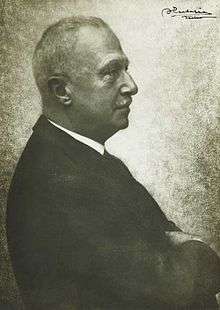Giovanni Agnelli
| Giovanni Agnelli | |
|---|---|
 Giovanni Agnelli | |
| Born |
13 August 1866 Villar Perosa, Italy |
| Died |
16 December 1945 (aged 79) Turin |
| Nationality | Italian |
| Known for | Founder of Fiat |
| Children |
Edoardo Agnelli Aniceta Caterina (1889 - 1928) |
| Relatives |
Gianni Agnelli (grandson) Susanna Agnelli (granddaughter) Giorgio Agnelli (grandson) Umberto Agnelli (grandson) Andrea Agnelli (great-grandson) John Elkann (great-great-grandson) |
Giovanni Agnelli (13 August 1866 – 16 December 1945) was an Italian entrepreneur, who founded Fiat car manufacturing in 1899.
Early life
The son of Edoardo Agnelli and Aniceta Frisetti, he was born in 1866 in Villar Perosa, a small town near Pinerolo, Piedmont, still the main home and burial place of the Agnelli family. His father, mayor of Villar Perosa, died at age 40, when Giovanni was just five. He studied at the Collegio San Giuseppe in Turin; then embarked on a military career until 1893 when he returned to Villar Perosa, where he followed in his father's footsteps and became mayor in 1895 which he held until his death. Agnelli heard about the invention of the (then) new horseless carriage and immediately saw an opportunity for using his engineering and entrepreneurial skills. In 1898, he met Count Emanuele Cacherano of Bricherasio, who was looking for investors for his horseless carriage project; Agnelli sensed the opportunity.
Business career
On 11 July 1899 Agnelli was part of the group of founding members of the Fabbrica Italiana di Automobili Torino, which became Fiat; he paid $400 for his share in 1899, worth around $11,500 in today's prices. One year later he was the managing director of the new company and became the chairman in 1920. The first Fiat plant opened in 1900 with 35 staff making 24 cars. Known from the beginning for the talent and creativity of its engineering staff; by 1903 Fiat made a small profit and produced 135 cars; this grew to 1,149 cars by 1906. The company then went public selling shares via the Milan stock exchange. Agnelli began purchasing all the shares he could adding to his holding, overcoming scandals and labour problems.
During World War I (1914–18) Agnelli became involved with the financier Riccardo Gualino in transport of US aid to Europe in 1917. They invested in two enterprises in the United States; the Marine & Commerce Corporation of America exported coal and the International Shipbuilding Company made motorized vessels. These companies failed when the war ended, since they were structured to meet wartime demand, but had returned large profits to their owners.[1] Agnelli and Gualino made an attempt early in 1918 to take over Credito Italiano. They did not succeed, but joined the board of directors of the bank.[2] Agnelli was vice-president of Gualino's SNIA from 1917 to 1926. In the early 1920s SNIA began to manufacture artificial textile fibers. In 1920 Gualino and Agnelli participated in recapitalization of the private bank Jean de Fernex, and bought a third of the shares of Alfredo Frassati, publisher of La Stampa.[3] Gualino and Agnelli were also involved in a proposal to link Milan, Genoa and Turin with a high-speed railway, and in various projects in cement and automobiles. Their partnership broke up around 1926 due to Gualino's investments in the French automobile industry.[1]
After World War I Fiat jumped from 30th to third place among Italian industrial companies. The first Ford factory was opened four years after Fiat was founded and already in 1906 a first Fiat car dealer in US was established, in Manhattan, Broadway. Agnelli was appointed a Senator in 1923, and filled several other prestigious positions between the two wars. He remained focused and propelled Fiat to the international arena. He was still active with FIAT at the start of the Second World War, and died soon after it ended in 1945 at age 79.
Honours
- Knight of the Order of Labour (30 May 1907)
- Grand Officer of the Order of Saints Maurice and Lazarus (6 February 1921)
- Knight Grand Cross of the Order of the Crown of Italy (15 December 1932; Grand Officer: 1 February 1920; Knight: 8 December 1898)
- Inducted into the Automotive Hall of Fame in 2002.[4]
- Inducted into the European Automotive Hall of Fame in 2001.[5]
Notes
- 1 2 Chiapparino 2003.
- ↑ Zamagni 1993, p. 233.
- ↑ Riccardo Gualino – Storia e Cultura.
- ↑ "Giovanni Agnelli". Hall of Fame Inductees. Automotive Hall of Fame. 2002. Retrieved March 4, 2016.
- ↑ Johnson, Richard. "Thirteen wise men who shaped the course of European auto history". Automotive News. European Automotive Hall of Fame. Retrieved March 4, 2016.
Sources
- Chiapparino, Francesco (2003). "GUALINO, Riccardo". Dizionario Biografico degli Italiani (in Italian). 60. Trecanni. Retrieved 2015-07-25.
- "Riccardo Gualino". Storia e Cultura dell'Industria. Retrieved 2015-07-24.
- Zamagni, Vera (1993-10-28). The Economic History of Italy 1860-1990. Clarendon Press. ISBN 978-0-19-159022-1. Retrieved 2015-07-26.
- Marco Ferrante, Casa Agnelli, Mondadori, 2007, ISBN 978-88-04-56673-1
- Alan Friedman, Agnelli and the network of italian power, Mandarin Paperback (Octopus Publishing Gr.), London, 1988, ISBN 0-7493-0093-0
- Marina Ripa di Meana e Gabriella Mecucci, Virginia Agnelli, Argelato (BO), Minerva Edizioni, 2010, ISBN 978-88-7381-307-1
- Gustavo Mola di Nomaglio, Gli Agnelli. Storia e genealogia di una grande famiglia piemontese dal XVI secolo al 1866, Torino, Centro Studi Piemontesi, 1998, ISBN 88-8262-099-9